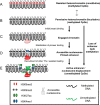Pioneer transcription factors shape the epigenetic landscape
- PMID: 29507097
- PMCID: PMC6130937
- DOI: 10.1074/jbc.R117.001232
Pioneer transcription factors shape the epigenetic landscape
Abstract
Pioneer transcription factors have the unique and important role of unmasking chromatin domains during development to allow the implementation of new cellular programs. Compared with those of other transcription factors, this activity implies that pioneer factors can recognize their target DNA sequences in so-called compacted or "closed" heterochromatin and can trigger remodeling of the adjoining chromatin landscape to provide accessibility to nonpioneer transcription factors. Recent studies identified several steps of pioneer action, namely rapid but weak initial binding to heterochromatin and stabilization of binding followed by chromatin opening and loss of cytosine-phosphate-guanine (CpG) methylation that provides epigenetic memory. Whereas CpG demethylation depends on replication, chromatin opening does not. In this Minireview, we highlight the unique properties of this transcription factor class and the challenges of understanding their mechanism of action.
Keywords: DNA demethylation; cell differentiation; chromatin remodeling; development; epigenetics; gene transcription.
© 2018 by The American Society for Biochemistry and Molecular Biology, Inc.
Conflict of interest statement
The authors declare that they have no conflicts of interest with the contents of this article
Figures


References
-
- Garcia-Bellido A. (1975) Genetic control of wing disc development in Drosophila. Ciba Found. Symp. 0, 161–182 - PubMed
-
- Sérandour A. A., Avner S., Percevault F., Demay F., Bizot M., Lucchetti-Miganeh C., Barloy-Hubler F., Brown M., Lupien M., Métivier R., Salbert G., and Eeckhoute J. (2011) Epigenetic switch involved in activation of pioneer factor FOXA1-dependent enhancers. Genome Res. 21, 555–565 10.1101/gr.111534.110 - DOI - PMC - PubMed
Publication types
MeSH terms
Substances
LinkOut - more resources
Full Text Sources
Other Literature Sources

